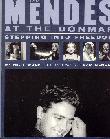SITE GUIDE
SEARCH
REVIEWS
REVIEW ARCHIVES
ADVERTISING AT CURTAINUP
FEATURES
NEWS
Etcetera and
Short Term Listings
LISTINGS
Broadway
Off-Broadway
NYC Restaurants
BOOKS and CDs
OTHER PLACES
Berkshires
London
California
New Jersey
DC
Philadelphia
Elsewhere
QUOTES
TKTS
PLAYWRIGHTS' ALBUMS
LETTERS TO EDITOR
FILM
LINKS
MISCELLANEOUS
Free Updates
Masthead
A CurtainUp Review
The Mystery Plays
By Brad Bradley

Gavin Creel
|
The first half, "The Filmmaker's Mystery," deals with an accidental meeting and an apparently accidental train crash that destroys all its passengers but for Joe Manning, the narrating protagonist, himself mysteriously delayed at an interim stop en route to his destination. The story is quite other-worldly, often baffling and annoyingly so in its final third, but thoroughly captivating until the mystery turns to mud and the work feels unfinished. Yet the acting is so compelling that the weaknesses of the writing are partly overcome. Gavin Creel is excellent as the curious and eccentric filmmaker, his buoyant energy and passion for weirdness totally dominating the stage. The supporting cast is solid in assorted roles, especially Leslie Lyles as a deliciously blunt film agent and Scott Ferrara as an intriguing and later haunting presence.
The second half, "Ghost Children," is considerably higher on the scale of creepiness, its pivotal incident being a triple murder by an abused and disturbed teenage boy of his horrid parents and his innocent 11-year-old sister as well. If there's a mystery here, that's a mystery in itself. The story is told by Abbey, the other sister, 15 years after the murders. Then a mid-teen herself, and now a successful attorney, Abbey still is haunted by her brother's unforgettable deed and is trying to maintain her own sanity at a safe distance from the incarcerated older sibling. Heather Mazur is excellent as the haunted sister, but the narrative mode serves her less well than it does Joe Manning, perhaps because her character is considerably more passive and reactive than is that of Joe in the earlier piece. Peter Stadlen is superb as Abbey's brother Ben, both in the contemporary scenes as a matured and perhaps reformed prison inmate, as well as in the flashback material when he convincingly portrays a teenager so repressed and disturbed that he loses all control.
Linking the two halves of the evening is a character called Mister Mystery, who, while effectively portrayed by Mark Margolis, comes across as a superficial trick, being something of a cartooned hybrid of Wilder's Stage Manager and a Bogart-like gumshoe. Margolis and the rest of the cast all are wonderful in assorted smaller roles. They are well aided by Sandra Goldmark's simple yet fluid set design (including a very functional modular archway and a versatile gauze curtain) and S. Daniel Baker's sound design that bridges time and set changes with dead-on mood music. The lighting design by Ryan Schmidt also is impressive. Connie Grappo's direction is full of energy and character development. But all these production strengths are not quite enough to make The Mystery Plays satisfying.
There are some elements here of the existential theatrical question, "What is the truth, and when is it replaced by an illusion?" Unfortunately, this philosophical consideration is merely hinted at rather than developed. Fans of such notions will get considerably more dramatic payoff from the masters (e.g., the likes of Pirandello, Pinter and Albee).
|
The Mystery Plays
Written by Roberto Aguirre-Sacasa Directed by Connie Grappo Cast: Mark Margolis, Gavin Creel, Scott Ferrara, Peter Stadlen, Leslie Lyles, and Heather Mazur. Set Design: Sandra Goldmark Costume Design: Amanda Walker Lighting Design: S. Ryan Schmidt Sound Design: Daniel Baker Running time: 2 hours, 15 minutes including one intermission. Presented by Second Stage Theatre in association with Yale Repertory Theatre at McGinn/Cazale Theatre, Broadway at 76th St.(212) 246-4422 6/21/04 to 7/10/04; opened 6/28/04 Viewed by Brad Bradley at Friday, June 25 preview. |

Retold by Tina Packer of Shakespeare & Co.
Click image to buy.
Our Review

Mendes at the Donmar
Our Review

At This Theater

Leonard Maltin's 2003 Movie and Video Guide

Ridiculous!The Theatrical Life & Times of Charles Ludlam

6, 500 Comparative Phrases including 800 Shakespearean Metaphors by CurtainUp's editor.
Click image to buy.
Go here for details and larger image.



